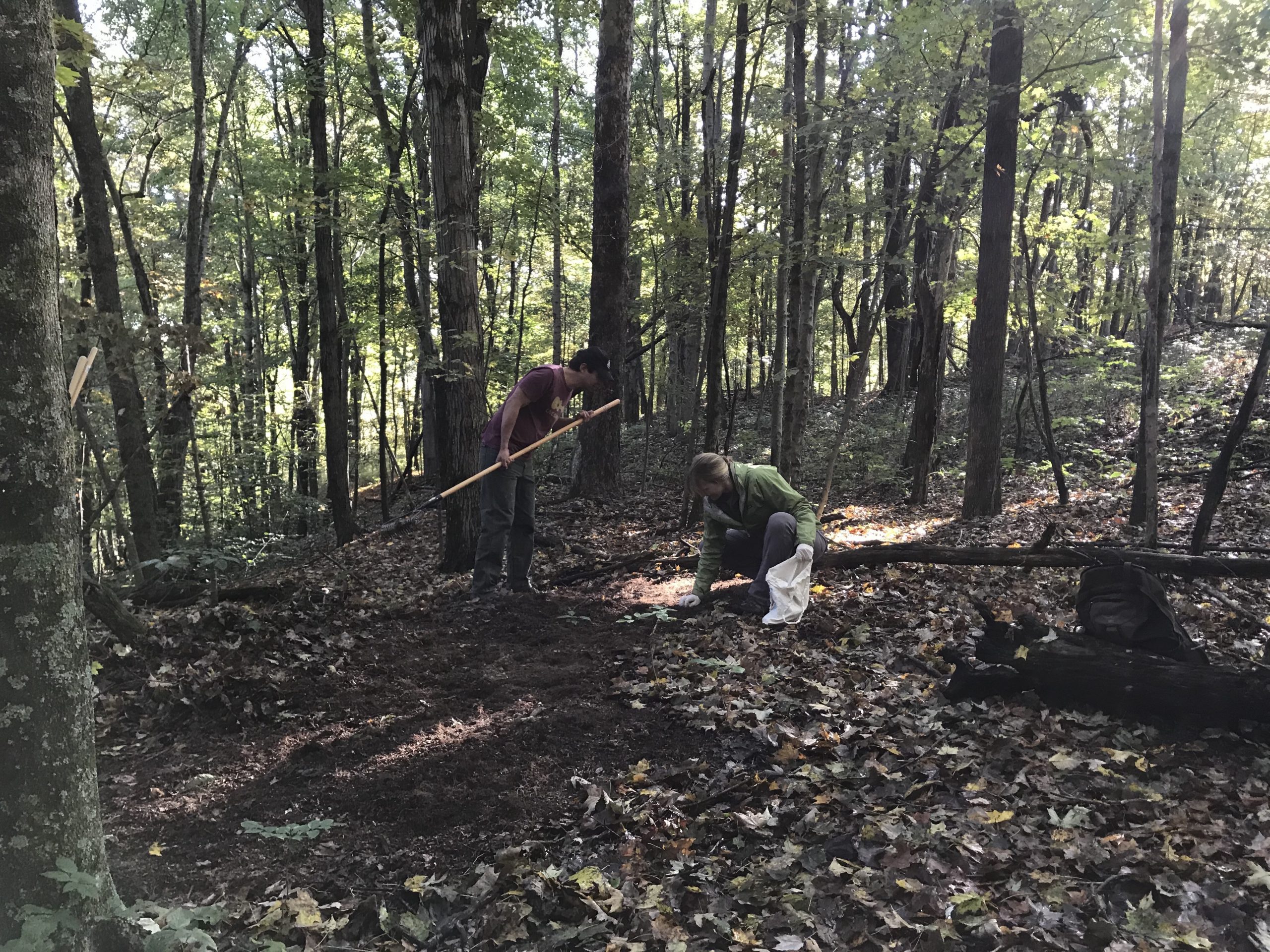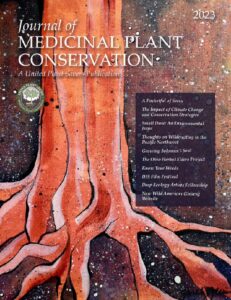A Grower’s Track and Cultivation & Conservation Track were presented at the 2017 and 2019 International Herb Symposium. Both have been made available here with support from the Claude Worthington Benedum Foundation.
Select a track title below to read the class descriptions and listen to the audio recordings.
Grower’s Track (IHS 2017)
This session will provide an introduction to production and marketing of wild-simulated ginseng, including the history of ginseng markets, site selection, planting techniques, crop maintenance, harvesting, and marketing. This session will go into the status of wild ginseng and the conservation efforts taking place to ensure its future, as well as why a domestic market can help conserve our most iconic American medicinal plant.
This session will provide an introduction to production and marketing of wild-simulated ginseng, including the history of ginseng markets, site selection, planting techniques, crop maintenance, harvesting, and marketing. This session will go into the status of wild ginseng and the conservation efforts taking place to ensure its future, as well as why a domestic market can help conserve our most iconic American medicinal plant.
This session will provide an introduction to production and marketing of wild-simulated ginseng, including the history of ginseng markets, site selection, planting techniques, crop maintenance, harvesting, and marketing. This session will go into the status of wild ginseng and the conservation efforts taking place to ensure its future, as well as why a domestic market can help conserve our most iconic American medicinal plant.
Plant response to environment sets the phytochemical stage for the constituents we in turn call upon in herbal healing. Understanding plant health in deeper ways allows us to grow holistically while at the same time work with mycorrhizal fungi to build outrageously healthy soil. Growing nutrient-dense foods and phytochemically-rich herbs comes down to emulating the practical ways that Nature does health.
If you understand the uses of garlic, you understand 50% of all herbal medicine. Come learn how to successfully grow great garlic, the constituent alchemy of organo-sulfur compounds, and then how to use this healing plant for effective medicine and delectable eating. Michael hasn’t met an herbalist yet who doesn’t derive profound satisfaction from homegrown bulbs.
In this intensive, Andrea and Matthias Reisen of Healing Spirits Herb Farm will share their experiences over the last 25 years of all aspects of medicinal herb farming. Propagating, growing, drying, field preparation, processing and how they are now working with aquaponics and mushrooms. There are many avenues to making a living, working that small piece of land and tickling the belly of the earth.
From roots to shoots, green practitioners and businesses are relying on local farms as a primary source of herbal ingredients. An understanding of industry resources, ingredient specifications, and economics will determine future success of our domestic supply chain.
Participants will enjoy the full circle experience of mushroom cultivation, harvesting, preparation, extractions, product development for personal care products and medicinal fungal foods. Tradd uses a combination of visual slides, destructed demos and hands on activities that makes the entire process a memorable and efficient learning experience. Learn basic mushroom cultivation principles, how the chemical properties of fungi are affected by their environment, and how you can create potent extracts and innovative medicinal and culinary products for home, family or your business’ product development.
Perhaps the greatest task facing American Herbalists today is learning to be not only stewards of our herbal traditions but also stewards and caretakers of the healing plants themselves. What does being a steward of healing herbs mean? How do we preserve our precious plant resources while promoting wild crafting, herbal medicine making, and herbal healing practices. In this insightful and inspiring discussion, Rosemary will share important stewardship practices including determining which plants are ‘at risk’ of over use and creating land as sanctuary.
This session will cover conservation concerns for those Appalachian forest botanicals on the At-risk List that are currently in high demand in the herbal trade. We will discuss methods for forest farming, resources and networks such as the www.appalachianforestfarmers.org and UpS upcoming symposium July 2017 “The Future of Ginseng and Forest Botanicals” to be held in Morgantown, WV.
A deeper understanding of particle density, nutrient availability and water retention are essential to successful herb farming. Learn about the tools and techniques that affect our herbal underground world.
This session will provide an introduction to ramp cultivation, including site selection, planting techniques, harvesting, marketing, seed collection, and a discussion of wild stewardship and conservation. This session will further cover the history and medicinal value of ramps. Learn about conservation efforts to promote just using the leaves!
iframe src=”https://drive.google.com/file/d/1hmqT2kN6YGyLZ8pUvMxI3l_Uo5tSkGgc/preview” width=”100%” height=”auto”>Biodynamic agriculture is a way of living, working, and relating with nature’s rhythms and the vocations of agriculture based on good common-sense practices, a consciousness of the uniqueness of each landscape, and the inner development of each and every practitioner. The philosophy and foundational practices of biodynamics will be introduced (including soil and compost preparations), working with cosmic rhythms through the biodynamic planting calendar, and a participatory stirring and spraying demonstration of one of the biodynamic preps.
Cultivation & Conservation Track (IHS 2019)
I will discuss some of the propagation techniques I have utilized over many years of experience and share some secrets also. Then we will get our hands dirty and I’ll demonstrate, so bring your gloves and pots to take some plants home with you.
United Plant Savers has been deeply invested in conservation research and advocacy of three deeply culturally sacred plants. Come learn about the five year study on sustainable harvest of osha in high altitude mountains of Colorado, ongoing reforestation project of Hawaiian sandalwood and dive into the plant lust that is damaging wild populations of white sage. We will explore how the UpS At-Risk tool works and hear stories of grassroots conservation in action for medicinal plants. We will wrap the class up with information on United Plant Savers current programs, and how to become a United Plant Savers botanical sanctuary.
Through a colorful slideshow, we will view images of and discuss a variety of medicinal and edible trees and shrubs and medicinal herbs and flowers, all of which can be incorporated into hedgerows growing along the edges of gardens, fields or stonewalls. Hedgerows have many purposes including food and shelter for birds; nectar and pollen for pollinators, medicine and food for people, magical spaces for children and elemental beings, and beauty and shade. (Focused on New England plants and trees)
This class will focus on how to sustainably cultivate, manage, and market wild-simulated ginseng roots at any scale. Topics discussed will include an overview of ginseng biology and habitat requirements, site selection and evaluation, planting techniques, marketing strategies, and more.
I’ll share techniques I have utilized to both improve the overall quality and increase specific constituent levels in different crops. From an Irrigation Regulated Deficit Study to Shade Percentage Affects on Yield & Seed Production.
In this class we will learn about rainforest plant medicine traditions among several of the indigenous peoples communities I’ve worked with in the Ecuadorian Amazon. We will examine different aspects of these traditions and hold a group discussion as to why they may be prevalent in order to best reach an understanding of their purposes. Why the Secoya never walk behind the pot of ceremonial yage when it is cooking. How the Waorani make their arrow poisons and how they learned to make it. I will conclude the class with a story about how some of these traditions are used in the preservation of the rainforest.
In this class we will learn about rainforest plant medicine traditions among several of the indigenous peoples communities I’ve worked with in the Ecuadorian Amazon. We will examine different aspects of these traditions and hold a group discussion as to why they may be prevalent in order to best reach an understanding of their purposes. Why the Secoya never walk behind the pot of ceremonial yage when it is cooking. How the Waorani make their arrow poisons and how they learned to make it. I will conclude the class with a story about how some of these traditions are used in the preservation of the rainforest.
Wherever one lives, an apothecary garden can be created or expanded to include herbs which nourish, heal and inspire joy, inner peace and wellness. Building living soil and compost, and incorporating specific design elements will be included along with suggestions for herbs which are medicinally purposeful and pollinator friendly. This class especially welcomes folks who are looking to create healing gardens and sanctuary spaces in places such as schools, prisons, shelters, food banks, community centers, nursing care facilities, and hospitals.
I’ll share stories and pictures from around the world showing how they utilize what is around them to grow, harvest and dry the medicinal herbs they sell us and also the ones they use.
This session will provide a basic introduction to establishing small-scale forest farming systems for at-risk woodland medicinal herbs, with a focus on the sustainable production and marketing of goldenseal, black cohosh, ramps, and bloodroot.
This class will be a historical journey of classic literature/art of medicinal parasitic plants found around the world, such as Pedicularis spp., Cynomorium coccineum, Euphrasia spp., Monotropa spp., Santalum spp., and others. The understanding of these plants coincides with the scientific literation of parasites in the human body. This overlap mutualistic interconnecting exchanges comes into view with the invention of the microscope and cellular understanding that emerges in the mid 1800’s. Our understanding of fungal relationships and interconnected networks of exchanging nutrients is changing how we view the landscapes. This research expands our thinking not just of fungi, but also to those parasitic and hemi-parasitic medicinal plants that also have implications in not just how we understand their role in the ecology but also how they inform conservation when cultivation is not a viable option.
Growing mushrooms is easy. Understanding the purpose and relationships with the fungus, the environment, and the cultivator requires another dimension in observation, empathy, and selflessness. The quality of a medicinal mushroom is a direct result of their upbringing and environment. Learn how to think like a mushroom” and create a special bond with our fungal friends.






